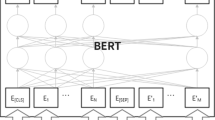Abstract
The ICD-9 terminology standardization task aims to standardize the colloquial terminology recorded by doctors in medical records into the standard terminology defined in the ninth version of International Classification of Diseases (ICD-9). In this paper, we first propose a BERT and Text Similarity Based Method (BTSBM) that combines BERT classification model with text similarity calculation algorithm: 1) use the N-gram algorithm to generate a Candidate Standard Terminology Set (CSTS) for each colloquial terminology, which is used as the training dataset and test dataset for next step; 2) use the BERT classification model to classify the correct standard terminology. In this BTSBM method, if a larger-scale CSTS is taken as the test dataset, the training dataset also needs to maintain larger-scale. However, there is only one positive sample in each CSTS. Hence, expanding the scale will cause a serious imbalance in the ratio of positive and negative samples, which will significantly degrade system performance. While if we keep the test dataset relatively small, the CSTS Accuracy (CSTSA) will degrade significantly, which results a very low system performance ceiling. In order to address above problems, we then propose an optimized terminology standardization method, called as Advanced BERT and Text Similarity Based Method (ABTSBM), which 1) uses a large-scale initial CSTS to maintain a high CSTSA to ensure a high system performance ceiling, 2) denoises CSTS based on body structure to alleviate the imbalance of positive and negative samples without reducing the CSTSA, and 3) introduces the focal loss function to further promote a balance of positive and negative samples. Experiments show that, the precision of the ABTSBM method is up to 83.5%, which is 0.6% higher than BTSBM, while the computation cost of ABTSBM is 26.7% lower than BTSBM.
Access this chapter
Tax calculation will be finalised at checkout
Purchases are for personal use only
Similar content being viewed by others
References
Liu, T.: Development and application of clinical ICD-10 entry system. People’s Military Surgeon 59(1), 96–97 (2016)
Cheng, C., Huang, H., Ou, D.: Design and application of automatic coding for disease diagnosis. Chin. Med. Record 19(9), 96–97 (2018)
Nitesh, P., Manasi, G., Rajesh, W.: A review on text similarity technique used in IR and its application. Int. J. Comput. Appl. 120, 29–34 (2015)
Wang, C., Yang, Y., et al.: A review of text similarity approaches. Inf. Sci. 37(03), 158–168 (2019)
Erjing, C., Enbo, J.: A survey of research on text similarity calculation methods. Data Anal. Knowl. Discovery 1(6), 1–11 (2017)
Brown, P.F., Pietra, V.J.D., Souza, P.V.D., et al.: Class-based n-gram models of natural language. Comput. Lingus 18(4), 467–479 (1992)
Irving, R., Fraser, C.: Two algorithms for the longest common subsequence of three (or more) strings. DBLP (1992)
Navarro, G.: A guided tour approximate string matching. ACM Comput. Surv. (CSUR) (2001)
Yu, T., Xu, P., et al.: Text similarity method based on the improved jaccard coefficient. Comput. Syst. Appl. 26(12), 137–142 (2017)
Sidorov, G., Helena, G., Markov, I., et al.: Computing text similarity using tree edit distance. Fuzzy Inf. Process. Soc. IEEE (2015)
Kenter, T., Rijke, M.D.: Short text similarity with word embeddings. In: ACM International on Conference on Information & Knowledge Management. ACM (2015)
Mikolov, T.: Distributed representations of words and phrases and their compositionality. Adv. Neural. Inf. Process. Syst. 26, 3111–3119 (2013)
Pennington, J., Socher, R., Manning, C.D.: GloVe: global vectors for word representation. In: Proceedings of the 2014 Conference on Empirical Methods in Natural Language Processing, pp. 1532–1543 (2014)
Devlin, J., Chang, M.W., Lee, K., et al.: BERT: pre-training of deep bidirectional transformers for language understanding (2018)
Chalapathy, R., Borzeshi, E.Z., Piccardi, M.: Bidirectional LSTM-CRF for Clinical Concept Extraction (2016)
Lin, T.Y., Goyal, P., Girshick, R., et al.: Focal loss for dense object detection. IEEE Trans. Pattern Anal. Mach. Intell. PP(99), 2999–3007 (2017)
Author information
Authors and Affiliations
Editor information
Editors and Affiliations
Rights and permissions
Copyright information
© 2021 The Author(s), under exclusive license to Springer Nature Switzerland AG
About this paper
Cite this paper
Liu, Y., Ji, B., Yu, J., Tan, Y., Ma, J., Wu, Q. (2021). An Advanced ICD-9 Terminology Standardization Method Based on BERT and Text Similarity. In: Meng, H., Lei, T., Li, M., Li, K., Xiong, N., Wang, L. (eds) Advances in Natural Computation, Fuzzy Systems and Knowledge Discovery. ICNC-FSKD 2020. Lecture Notes on Data Engineering and Communications Technologies, vol 88. Springer, Cham. https://doi.org/10.1007/978-3-030-70665-4_202
Download citation
DOI: https://doi.org/10.1007/978-3-030-70665-4_202
Published:
Publisher Name: Springer, Cham
Print ISBN: 978-3-030-70664-7
Online ISBN: 978-3-030-70665-4
eBook Packages: Intelligent Technologies and RoboticsIntelligent Technologies and Robotics (R0)




